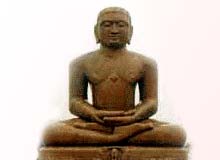 Jains form less than one percent of the Indian population. For centuries, Jains are famous as community of traders and merchants. The states of Gujarat and Rajasthan have the highest concentration of Jain population in India. The Jain religion is traced to Vardhamana Mahavira (The Great Hero 599-527 B.C.). Mahavira was the twenty-fourth and last of the Jain Tirthankars. Mahavira was born in a ruling family of Vaishali, located in the modern state of Bihar, India. At the age of thirty, Mahavira renounced royal life and devoted himself to the task of discovering the meaning of existence. At the age of 42 he attained enlightenment and spent the rest of his life meditating and preaching Jainism.
Jains form less than one percent of the Indian population. For centuries, Jains are famous as community of traders and merchants. The states of Gujarat and Rajasthan have the highest concentration of Jain population in India. The Jain religion is traced to Vardhamana Mahavira (The Great Hero 599-527 B.C.). Mahavira was the twenty-fourth and last of the Jain Tirthankars. Mahavira was born in a ruling family of Vaishali, located in the modern state of Bihar, India. At the age of thirty, Mahavira renounced royal life and devoted himself to the task of discovering the meaning of existence. At the age of 42 he attained enlightenment and spent the rest of his life meditating and preaching Jainism. Jainism rests on a real understanding of the working of karma, its effects on the living soul and the conditions for extinguishing action and the soul's release. Jainism considers the soul as a living substance
that combines with various kinds of non-living matters. The Jain religion rests on complete inactivity and absolute nonviolence (ahimsa) against all living beings. It is evident from the Jain monks and nuns wearing face masks to avoid inhaling small organisms. It is for the same reason all practicing Jains try to remain vegetarians.
The Jain community evolved into two main divisions- the Digambara or "sky-clad" monks do not wear clothes and the Svetambara or "white-clad" monks and nuns, who wear white clothes and carry bowls for collecting food. For centuries Western and southern India have been Jain strongholds. In the mid-1990s, there were about 7 million Jains, the majority of whom live in the states of Maharashtra (mostly in Bombay), Rajasthan, and Gujarat. Karnataka, conventionally a stronghold of Digambaras, also has a considerable Jain community.
Though the Jain shrines include images of the Tirthankars, yet they are not worshiped but remembered and revered. Daily rituals of the Jains may include meditation, bathing the images, offering food, flowers and light lamps for the images. It is interesting to note that the Jains also worship local gods and participate in Hindu or Muslim celebrations without compromising their fundamental path. The Jains celebrate the five major events in the life of Mahavira- conception, birth, renunciation, enlightenment, and final release after death.
Major Jain pilgrimage destinations in India are Palitana, Ranakpur, Shravanbelagola, Dilwara Temple, Khandagiri Caves and Udayagiri Caves.
No comments:
Post a Comment